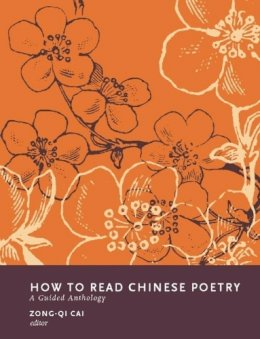
Stock image for illustration purposes only - book cover, edition or condition may vary.
How to Read Chinese Poetry: A Guided Anthology
Zong-Qi (Ed) Cai
€ 60.93
FREE Delivery in Ireland
Description for How to Read Chinese Poetry: A Guided Anthology
Paperback. Leads us through the major genres and eras of Chinese poetry from antiquity to the modern time. This volume is divided into 6 chronological sections and features more than 140 examples of shi, sao, fu, ci, and qu poems. It highlights the thematic, formal, and prosodic features of Chinese poetry. It presents poems in Chinese and English. Editor(s): Cai, Zong-qi. Num Pages: 456 pages, black & white illustrations. BIC Classification: 2GDC; DC; DSC. Category: (P) Professional & Vocational. Dimension: 280 x 216 x 21. Weight in Grams: 1056. A Guided Anthology. 456 pages, illustrations. Editor(s): Cai, Zong-qi. Leads us through the major genres and eras of Chinese poetry from antiquity to the modern time. This volume is divided into 6 chronological sections and features more than 140 examples of shi, sao, fu, ci, and qu poems. It highlights the thematic, formal, and prosodic features of Chinese poetry. It presents poems in Chinese and English. Cateogry: (P) Professional & Vocational. BIC Classification: 2GDC; DC; DSC. Dimension: 280 x 216 x 21. Weight: 1072.
In this "guided" anthology, experts lead students through the major genres and eras of Chinese poetry from antiquity to the modern time. The volume is divided into 6 chronological sections and features more than 140 examples of the best shi, sao, fu, ci, and qu poems. A comprehensive introduction and extensive thematic table of contents highlight the thematic, formal, and prosodic features of Chinese poetry, and each chapter is written by a scholar who specializes in a particular period or genre. Poems are presented in Chinese and English and are accompanied by a tone-marked romanized version, an explanation of Chinese linguistic and poetic conventions, and recommended reading strategies. Sound recordings of the poems are available online free of charge. These unique features facilitate an intense engagement with Chinese poetical texts and help the reader derive aesthetic pleasure and insight from these works as one could from the original. The companion volume How to Read Chinese Poetry Workbook presents 100 famous poems (56 are new selections) in Chinese, English, and romanization, accompanied by prose translation, textual notes, commentaries, and recordings. Contributors: Robert Ashmore (Univ. of California, Berkeley); Zong-qi Cai; Charles Egan (San Francisco State); Ronald Egan (Univ. of California, Santa Barbara); Grace Fong (McGill); David R. Knechtges (Univ. of Washington); Xinda Lian (Denison); Shuen-fu Lin (Univ. of Michigan); William H. Nienhauser Jr. (Univ. of Wisconsin); Maija Bell Samei; Jui-lung Su (National Univ. of Singapore); Wendy Swartz (Columbia); Xiaofei Tian (Harvard); Paula Varsano (Univ. of California, Berkeley); Fusheng Wu (Univ. of Utah)
Product Details
Publisher
Columbia University Press
Number of pages
456
Format
Paperback
Publication date
2008
Condition
New
Number of Pages
456
Place of Publication
New York, United States
ISBN
9780231139410
SKU
V9780231139410
Shipping Time
Usually ships in 7 to 11 working days
Ref
99-1
About Zong-Qi (Ed) Cai
Zong-qi Cai is professor of Chinese and comparative literature at the University of Illinois, Urbana-Champaign. He is the author of The Matrix of Lyric Transformation: Poetic Modes and Self-Presentation in Early Chinese Pentasyllabic Poetry (Michigan, 1996) and Configurations of Comparative Poetics: Three Perspectives on Western and Chinese Literary Criticism (Hawai'i, 2002), and is the editor of A Chinese Literary Mind: Culture, Creativity, and Rhetoric in Wenxin dialong (Stanford, 2001) and Chinese Aesthetics: The Ordering of Literature, the Arts, and the Universe in the Six Dynasties (Hawai'i, 2004).
Reviews for How to Read Chinese Poetry: A Guided Anthology
By presenting poems in so many different forms: Chinese characters, Romanization, English translation, audio files, stress maps, and transliteration, the book enables the reader - no matter what her background in Chinese language, to grasp much of what is going on. BLT Not Just a Sandwich
